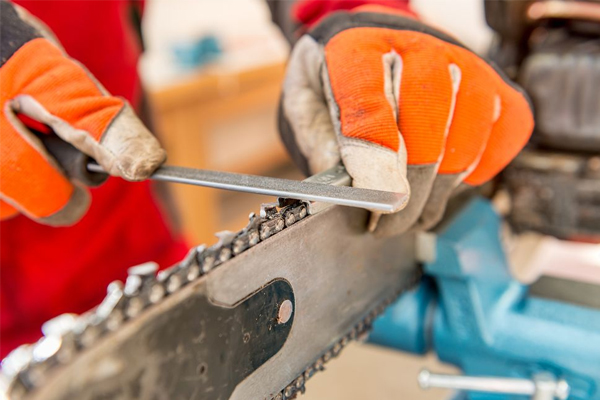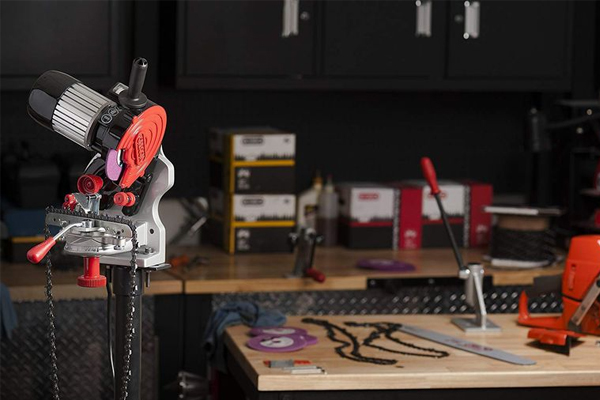
The application of chainsaws is remarkable in the forest-products industry as it helps to cut down any tree easily. However, the chainsaw chain starts to get dull over time. Eventually, you will find the chainsaw blade bucking and burning its path through the wood during cutting. This results in you experiencing a slow and dangerous way of cutting trees.
Nowadays, chainsaws are used by both DIYers and professional arborists. Most DIYers and even professionals need to know how to sharpen a chainsaw chain for their easy task execution. The best news is you can apply some of the best chainsaw sharpening tricks for the desired results. So, check this guide till the end to know more.
The usual rule of thumb is to sharpen the chainsaw chain when you observe that it's not cutting the tree as efficiently as before. You can also check out the sawdust, and if you find small chunks, consider it an indicator for your chain getting dull. If there are large chunks, your chain is sharp and fine.

You can determine whether a chainsaw is blunt or not by noticing these few things.
The saw chain never pulls itself into the tree wood. It needs pressure via the engine unit to forcibly cut the wood.
While doing a vertical cut, the saw chain will create extremely fine sawdust but not any coarse strands.
Even if the chain lubrication is in well-order and the chain tension is appropriate, you can find smoke cropping up the chainsaw.
If you see that the chainsaw runs in a particular direction resulting in a crooked cut, consider it an indicator of dull-cutting teeth or uneven cutting lengths of the teeth.
The chainsaw will bounce and rattle during a cut, leading to difficulty in precise positioning.
There is no fixed time interval for sharpening chainsaw chains. The chainsaw chain's quality and usage play a key role in determining when to sharpen the chainsaw. If you notice that you hit the chainsaw on something or it's not working well like before, consider it the time to sharpen them.
Before you start the operation of sharpening your chainsaw, you need to know uncertain things and consider several points for determining the best ways to sharpen a chainsaw. They are mentioned below, so check them all.

When sharpening the chainsaw, you must prepare all the safety equipment beforehand. Get your personal protective equipment for optimal safety measurements. You must get a protective helmet, ear defenders, goggles, chainsaw chaps, protective trousers and jacket, gloves, safety mitts, and lastly, a steel-toe boot.
For your safety precaution when sharpening the chainsaw, you must wear proper coveralls that fit well and personal protective items.
Are you wondering how to use a chainsaw file guide? Check below.
A file guide enables you to sharpen or file the chainsaw chain efficiently while making this tool extremely sharp. For getting precise and consistent results, mount the file on the chainsaw sharpening guide before you use the file.
Pros:
Cons:
Below is a detailed guide on how to sharpen a chainsaw blade with an electric sharpener. Check to know more.

Electric chainsaw sharpeners are powered by electricity that runs only if the device stays plugged into any electrical source, or you can use batteries.
Pros:
Cons:
You must be aware of all the specifications of your chainsaw blade before you jump into the actual sharpening job. The specifications that include the pitch and the gauge are crucial to know as they affect the usability of the chainsaw blade. You can find the measurement of these specifications on the chainsaw box or manual.
You must position your electric chainsaw sharpener properly once you get to know the pitch and gauge measurement. You must place the sharpener on the ground to avoid any sort of movement or shaking during the operation.
Now, install the sharpening stone. For doing it successfully, you need to take the help of the precise and correct measurement as discussed in step 1. Mostly, the width of any sharpening tool goes around 3/16 inches.
Swiveling must be your next step after installing the sharpening stone. Simply put the blade in the holder of the chainsaw sharpener and focus on adjusting the angle. Generally, the most common angles lie between 0-60 degrees. In some exceptional cases, the angle can reach up to 80 degrees.
Now, go back to the specification details to determine the tooth angle. In the chainsaw sharpener, easily adjust the chainsaw blade tooth angle by loosening a knob placed in the holder of the blade.
This step is crucial to position the depth stop properly as it prevents the grinder from cutting too deep.
Slowly lower the grinding wheel to make it contact the blade's first tooth. Keep them in contact for a short interval and then lift the grinding wheel to confirm whether the tooth's inner surface has a shiny outcome or not. This is how you sharpened the first tooth with the remaining to go. When done, readjust the grinding wheel and sharpen the next set of teeth.
This gadget is considered one of the most time-saving and energy-conserving parts of a chainsaw sharpening kit. This gadget is equipped with a grinding wheel of 4 ½ inch diameter instead of the woodcutting blade.
Pros:
Cons:
To meet the increasing curiosity of DIYers on how to sharpen a chainsaw with a grinder, we have shared some explicit details on it.
Using a grinder can indeed be a bit more complex than using a file guide, but once you know the steps, things will become easy. Grinder removes a lot of metal, so if not done correctly, you may end up replacing the entire chain.
Pros:
Cons:
Remember that no matter how experienced or skilled you're, sharpening a chainsaw can still be a dangerous task. Pick a place far away from pets and children. The disc of the grinder is too sharp, so hold the grinder very carefully.
Take a table with the perfect height and width for benefitting from doing tasks efficiently after placing the chainsaw on it. Ensure to get a firm grip on the grinder while locating the chains attached to it. If working with a fitted grinder, take off the chain from the saw and put it on the grinder's rail. This rotatable rail helps you work on both sides of the chainsaw chain.
Now, start up your grinder and work slowly and progressively by increasing the speed as you continue to sharpen. Also, you can notice alternating directions on each spike on the chain. You can choose to either grind every other spike or rotate the chain to do the rest for sharpening every spike properly. You can also turn the handheld grinder a bit for every spike to get them all in one flow.
If you want to keep the saw cutting in a straight line, go crazy about filing each and every cutter with the same stroke numbers and the same level of pressure.
Before any need for replacement, you can sharpen the cutters about ten times or more. If you find the chain cutters to get worn out unevenly after some sharpening sessions, a professional can easily regrind them to a uniform shape.
File guides clamping on the bar make sure that you file a similar angle on every cutter. They may take a bit longer, but they definitely restore the cutting edge to the precise factory-ground angle.
If you're using the same chainsaw chain for a few years, you need to replace them with a new one. The new one may initially give rougher cutting and faster-wearing results.
You must replace your chainsaw chain if you find the longest part of the cutting tooth to be less than the measurement of about 4 millimeters. Also, if you find any cracks on the chain, it's best to replace them.
The precise answer depends from one user to another, as every user has different requirements, tasks, and different frequencies in the tool usage. You must sharpen the chain wherever you find them to appear dull and inefficient.
You must sharpen the chainsaw by mounting the round file in the file guide. So, it's best to take the angle of 30-35 degrees for sharpening your chainsaw effectively.
You must use a round file to sharpen a chainsaw. The size can vary from 7/32 inch, 3/16 inch to 5/32 inch. The round file will be an ideal tool to sharpen the chain cutter's cutting edges.
A chainsaw chain's durability varies from one type to another. Even if every tool becomes dull at one point in time, the top-quality chain lasts for about one year of extensive usage or even a couple of years due to occasional usage before sharpening.
Your chainsaw chain can get dull so quickly due to some reasons, like the improperly sized file for the chain. Moreover, applying excess pressure when filing can also be a reason for them to get dull as it creates cutting edges.
If you sharpen and maintain your chainsaw efficiently and adequately, you will end up enjoying the smooth performance of the machine for over five years and more. If you use a chainsaw a lot, it's best to keep the portable sharpening tool as your backup tool into the forest or some other spot. You just check your chainsaw blade if there's an issue in its functioning. The more frequent the maintenance of your chainsaw, the better it will function.
https://www.familyhandyman.com/project/how-to-sharpen-a-chain-saw/
https://www.popularmechanics.com/home/tools/a21996/how-to-sharpen-chainsaw-tips/
https://www.husqvarna.com/us/discover/how-to-sharpen-a-chainsaw/
https://www.homedepot.com/c/ab/chainsaw-safety-tips/9ba683603be9fa5395fab90537f42e7
https://www.gardentoolexpert.com/how-often-do-you-need-to-sharpen-a-chainsaw-chain/
https://www.essentialhomeandgarden.com/electric-chainsaw-sharpener/